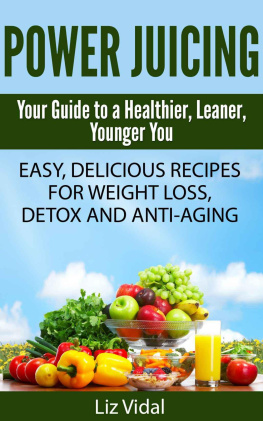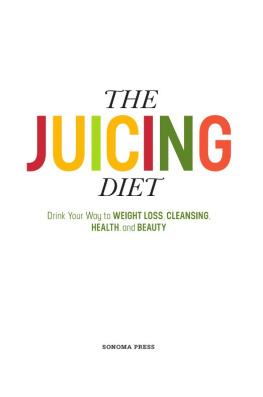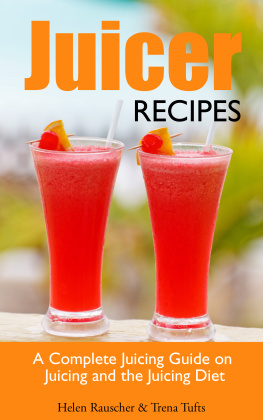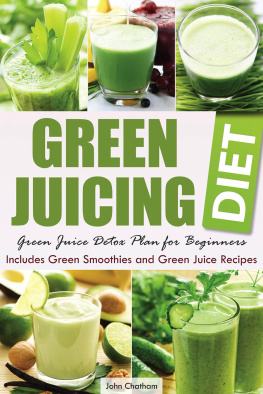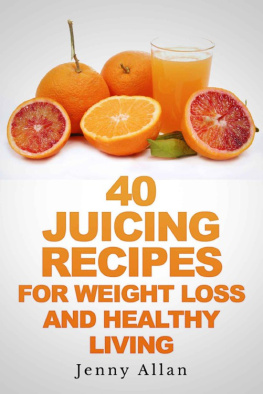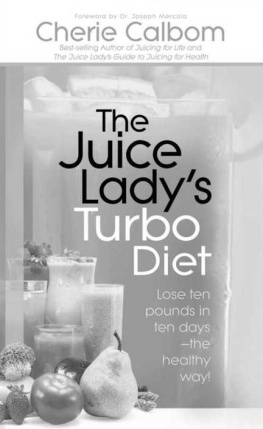Power Juicing
Your Quick Guide to a Healthier,
Leaner, Younger You
by Liz Vidal
Copyright Liz Vidal . All rights reserved.
Living Well Series
Edition: January 2013
No part of this publication may be reproduced, transmitted, transcribed, or translated into any language, in any form, or by any means, without written consent from the author.
Disclaimer
Every effort has been made in preparing this material to insure its accuracy.
The information contained in this publication is for educational purposes only. It is not medical advice and it is not intended to replace the advice of a physician or health-care professional.
This book has been carefully researched and checked for factual accuracy. Please consult your physician before changing your diet, starting an exercise, weight loss, or fat reduction program.
If you have diabetes, hypertension, high cholesterol, cardiovascular disease, or any other medical condition, consult a health care professional for your specific nutritional needs.
The views and statements expressed in this publication should not be construed as scientific conclusions.
The author of this book shall not be liable to any person or entity, for the information contained herein.
Table of Contents
Introduction
Fresh juices deliver all the nutritional benefits of fruits and vegetables in the most efficient way possible.
Digestive enzymes, found mainly in raw foods, play several key roles in our health, including converting the food we eat into body tissue and energy. Drinking fresh juices is one of the best methods of obtaining live enzymes.
Enzymes also play a key role in metabolism. For this reason, drinking fresh juices can increase your metabolic rate. A higher metabolic rate results in more energy and more calories burned.
This book will show you how to select a juicer (if you dont already have one) and how to make juicing a regular part of your life.
Natural vs. Bottled Juice
Bottled juices are certainly a better drink alternative than sodas and other sugary drinks, but they lack the nutritional value of fresh juices.
Bottle juices are pasteurized to improve shelf life. This means they are boiled to stop the growth of bacteria and other organisms.
Unfortunately, boiling also destroys many of the naturally occurring vitamins, minerals, and health-giving enzymes contained in the juice.
If youre fasting or juicing for weight loss, you need live foods to sustain your body.
Some bottled juices contain added sugar and water, but even if they are 100 percent natural, they cannot match the taste and nutritional value of freshly squeezed juices.
Detoxification
The liver is one of the most vital organs since it is involved in almost every aspect of the bodys processes.
The liver plays many critical roles, one of them being the detoxification or removal of foreign substances.
Although there are some juice combinations more geared towards cleansing the liver and gallbladder, the fact is that raw juices of all kinds support liver function on some level.
Naturally, any substance that supports the liver will also improve overall health.
Anti-Aging
With advanced aging there is an increased risk of degenerative diseases such as high blood pressure, high cholesterol and arthritis.
Most fruits and vegetables contain powerful antioxidants that can help in the treatment and prevention of these and other age related disorders.
Obesity and Disease
A rise in obesity has been linked to some common diseases including: diabetes II, coronary heart disease and even some types of cancer.
Fighting obesity through dieting and micro-nutrient supplementation may help prevent or delay the onset of these diseases.
Juicing for weight loss provides healthy micro-nutrients without overburdening the system with calories or fat.
Power Juicing for Energy
Our lives seem to get more hectic and stressful with every passing day. If you have children, then you know what is like to try to meet their needs and the demands of your busy schedule.
Juicing can help you recharge your system while maintaining stamina throughout the day, without resorting to caffeine, sugar or other stimulants.
Phytochemicals
Phytochemicals are substances found only in plants that are considered to be among the best disease-fighting nutrients.
Since most of us dont eat enough fruits and vegetables on a daily basis, juicing is a marvelous way to ensure we get our supply of these vital nutrients.
Nutritional Synergy
Juicing provides the added benefit of nutritional synergy. This means that the power of one nutrient is greatly enhanced when it is combined with another nutrient.
For instance, when vitamins E and Care combined together, they perform at an even greater capacity. The same holds true for beta-carotene, whose benefits are enhanced when combined with Zinc.
This synergistic effect is greatly magnified when we consume dozens of vitamins and minerals from fresh fruits and vegetables in the form of juice.
The Role of Fiber
Fibers are present in all plant foods. Categorized as soluble or insoluble , fiber helps to increase bulk, soften stools, and shorten the transit time of food as it moves through the intestinal tract.
Only the insoluble fiber is removed by the process of juicing. Freshly juiced fruits and vegetables still contain plenty of soluble fiber.
Soluble fiber dissolves in water and forms a gel that has a cleansing effect on the intestinal tract. Soluble fiber also binds to cholesterol preventing it from getting reabsorbed.
A diet that includes cleansing fiber is vital for maintaining a slim waistline, preventing constipation, bloating, inflammatory bowel disease, and even colon cancer.
Maximum Absorption
Drinking fruit and vegetable juice bypasses the digestive process. This means that most of the nutrients contained in raw juice are readily delivered to the bloodstream and cells, where your body can use them for healing, nourishing and repairing tissue.
Even though dietary supplements are helpful, the most efficient way to consume essential healing nutrients from whole foods is through freshly prepared juices.

There isnt a pill or powder that can deliver the nutritional power and live enzymes contained in these vegetables.
Only through juicing can we be sure to consume the minimum recommended daily allowance of fruits and vegetables that is necessary for optimal health.
What is the Difference Between Juices and Smoothies?
Juicing requires a juice extractor (also called pulp ejector) to separate liquid and nutrients from the fibrous pulp found in most vegetables.
Fruits and vegetables with a high water content such as, watermelons, oranges, grapefruits, grapes and tomatoes can be juiced without on a blender. But hard fruits and most vegetables, like apples, celery and carrots, can only be processed with a juicer.
Blenders are ideal for making smoothies, shakes or creamy soups. But when you toss hard or stringy vegetables in a blender, you end up creating a mushy paste.
Smoothies
Smoothies contain more fiber, since the entire fruit or vegetable goes into the blender.
They are thicker and creamier than juices, which makes them ideal as meal replacements since they are more filling.
Smoothies are very convenient since they can be prepared in a hurry. (Its easier to rinse a blender than a juicer).
Smoothies are great for beginners since most people already have a blender in their kitchen.
To prepare a smoothie, mix soft fruits (either fresh or frozen) with yogurt, buttermilk or nut milk, add some protein powder (this is optional) and you have a delicious fat free meal that can keep you satisfied for a couple of hours or more.
Next page
